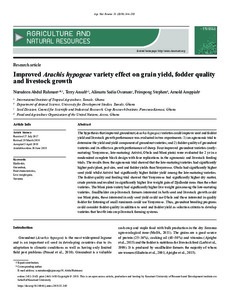| dc.contributor.author | Rahman, N.A. |
| dc.contributor.author | Ansah, T. |
| dc.contributor.author | Osuman, A.S. |
| dc.contributor.author | Stephen, F. |
| dc.contributor.author | Amppiah, A. |
| dc.date.accessioned | 2019-12-04T11:37:31Z |
| dc.date.available | 2019-12-04T11:37:31Z |
| dc.date.issued | 2019-06-30 |
| dc.identifier.citation | Rahman, N.A., Ansah, T., Osuman, A.S., Stephen, F. & Amppiah, A. (2019). Improved Arachis hypogeae variety effect on grain yield, fodder quality and livestock growth. Agriculture and Natural Resources, 53(3), 244-250. |
| dc.identifier.issn | 2452-316X |
| dc.identifier.uri | https://hdl.handle.net/20.500.12478/6523 |
| dc.description.abstract | The hypothesis that improved groundnut (Arachis hypogea) varieties could improve seed and fodder yield and livestock growth performance was evaluated in two experiments: 1) an agronomic trial to determine the yield and yield component of groundnut varieties; and 2) fodder quality of groundnut varieties and its effect on growth performance of sheep. Four improved groundnut varieties (early-maturing: Yenyawoso, late-maturing: Azivivi, Obolo and Mani pinta) were evaluated for 2 yr in a randomized complete block design with four replications in the agronomic and livestock feeding trials. The results from the agronomic trial showed that the late-maturing varieties had significantly higher pods/plant, pod size, seed and fodder yields than Yenyawoso. Obolo had significantly higher seed yield whilst Azivivi had significantly higher fodder yield among the late-maturing varieties. The fodder quality and feeding trial showed that Yenyawoso had significantly higher dry matter, crude protein and resulted in significantly higher live weight gain of Djallonké rams than the other varieties. The Mani pinta variety had significantly higher live weight gain among the late-maturing varieties. Smallholder crop-livestock farmers interested in both seed and livestock growth could use Mani pinta, those interested in only seed yield could use Obolo and those interested in quality fodder for fattening of small ruminants could use Yenyawoso. Thus, groundnut breeding programs could consider fodder quality in addition to seed and fodder yield as selection criteria to develop varieties that best fit into crop-livestock farming systems. |
| dc.description.sponsorship | United States Agency for International Development |
| dc.format.extent | 244–250 |
| dc.language.iso | en |
| dc.rights | Copyrighted; all rights reserved |
| dc.subject | Groundnuts |
| dc.subject | Body Weight |
| dc.subject | Savannas |
| dc.subject | Livestock |
| dc.subject | Growth |
| dc.subject | Grain |
| dc.subject | Fodder |
| dc.title | Improved arachis hypogeae variety effect on grain yield fodder quality and livestock growth |
| dc.type | Journal Article |
| dc.description.version | Peer Review |
| cg.contributor.affiliation | International Institute of Tropical Agriculture |
| cg.contributor.affiliation | University for Development Studies |
| cg.contributor.affiliation | Crops Research Institute |
| cg.contributor.affiliation | Food and Agriculture Organization of the United Nations |
| cg.coverage.region | Africa |
| cg.coverage.region | West Africa |
| cg.coverage.country | Ghana |
| cg.isijournal | ISI Journal |
| cg.authorship.types | CGIAR and developing country institute |
| cg.journal | Agriculture and Natural Resources |
| cg.howpublished | Formally Published |
| cg.accessibilitystatus | Limited Access |
| local.dspaceid | 109799 |
| cg.targetaudience | Scientists |
| cg.identifier.doi | https://dx.doi.org/10.34044/j.anres.2019.53.3.05 |

